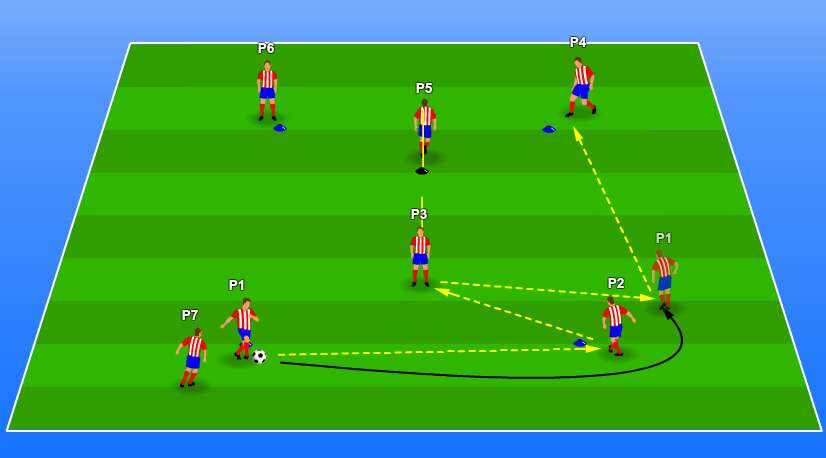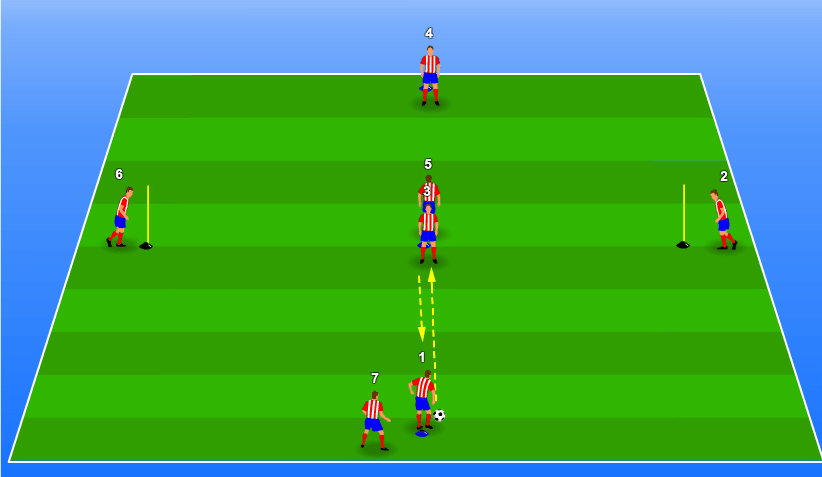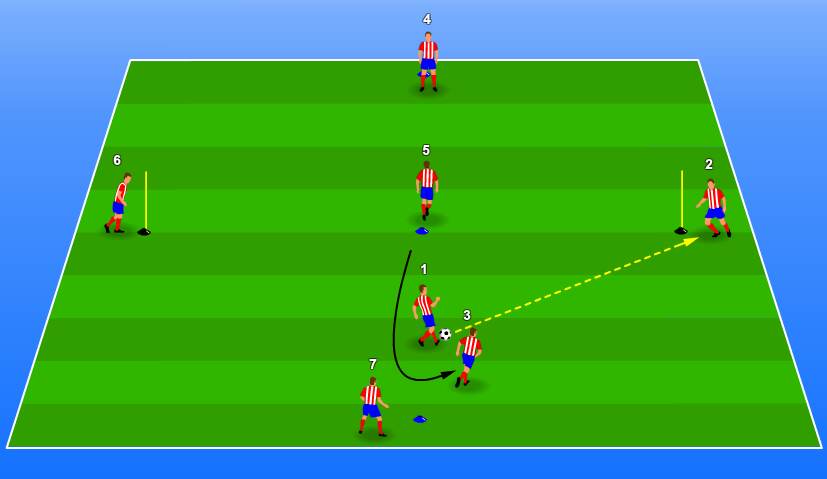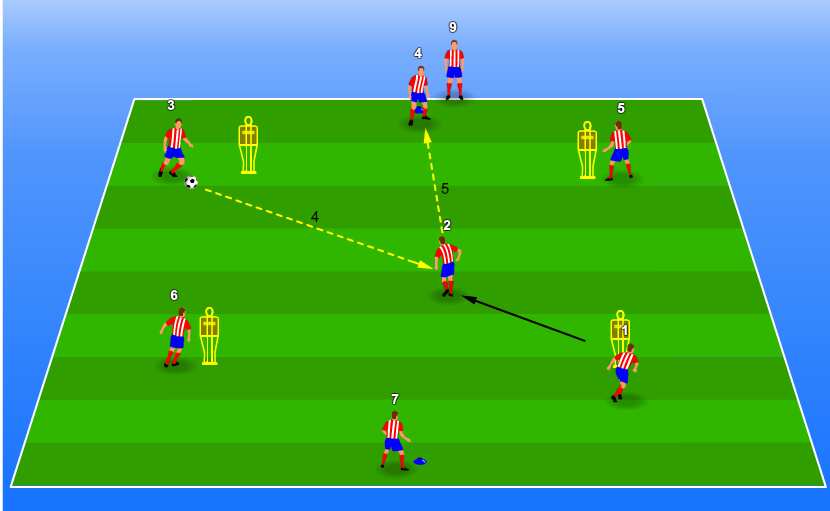Passing is one of the most important aspects of football, especially in an era where many coaches want their teams to dominate possession.
Whilst passing accuracy can be the difference between the opposition making an interception, due to a bad pass, or a player creating a goal-scoring opportunity.
Over the years I have used many of these exercises for my coaching sessions, designed to meet the needs of a mixture of age groups, so let me share them with you.
These 5 combination drills, if practiced regularly, will help improve your players’ control and passing technique.
- Overlapping Passing drill
- Third man running passing drill
- One-touch bounce passing drill
- Overlap bounce pass drill
- Diagonal passing drill
So here is how the 5 passing drills work…
Overlapping Passing Drill
In this passing drill, the intention of completing an overlapping run is added to the core focus of improving (and/or maintaining) the players’ passing ability.
The setup can be seen in the image below.

Training Drill Description:
- P1 passes the ball to P2 and then proceeds to make an overlapping run, around P2
- P2 controls the ball and then makes a pass into P3
- P3 makes a first-time pass into the running path of P1
- P1 controls the ball and makes a pass into P4
- The same routine is then repeated, starting from P4 passing to P5
Third Man Running Passing Drill
This passing drill is great to coach youngsters on the importance of continuing a run to receive the second or third pass.
The setup can be seen in the image below.

Training Drill Description:
- P1 Passes to P3
- P3 passes to P2
- P2 passes to P4
- P4 plays the ball into the path of P1
- P1 plays the ball into P5
- The sequence is continued with P5 and P6
One-Touch Bounce Passing Drill
This quick-fire drill aims to improve our players’ first-touch short-passing ability.
The setup can be seen in the image below.

Training Drill Description:
- P1 passes to P2
- P2 plays a first-time pass back to P1
- P1 passes to P3
- P3 passes to P2
- P2 passes to P4
- P4 passes to P3
- P3 passes to P5
- P5 passes toP4
- P4 passes to P6
- P6 passes to P5
- P5 passes to P1B
- P1B passes to P6
- P6 passes to P2B
- The sequence continues
Overlap Bounce Pass Drill
For this drill, the players will need to react quickly after each pass to move into position and receive another pass from a teammate.
The setup can be seen in the image below.



Training Drill Description:
- P1 passes to P2
- P2 returns the ball to P1 first time and then makes an overlapping run around P1
- P1 controls the ball before passing to P3
- P3 lays the ball off to P2, with P2 playing a one-two with P3
- P3 receives the ball whilst on the run and passes the ball to P4
- The sequence is repeated
Diagonal Passing Drill
This drill aims to enhance the player’s instinct to play diagonal passes.
The setup can be seen in the image below.


Training Drill Description:
- P1 passes to P2
- P2 passes the ball back to P1
- P1 controls the ball and passes to P3
- P3 lays the ball back to P2 (who has made a supporting run)
- P2 plays a first-time pass to P4
- The sequence is repeated from the other side
Besides setting up various passing drills, as coaches, we need to advise young players on several technical issues when executing a pass. So along with 2 individual passing training drills, here are those technical points.
What are the technical points to coach good passing?
The following points are some key elements of the basics of passing a ball.
- Body shape
- Weight of pass
- Timing of the pass
- Vision to see where teammates are positioned
Body shape
The body shape is crucial to set the player up correctly with the ball and ensure they can pass accurately.
Many young players are waiting on their heels to receive the ball which means they are not able to organise their feet in time when the ball arrives.
Emphasising the need to be alert and on the balls of their feet, will allow them to adjust their feet, get in line with the ball and therefore be in a better position to control the ball.
Once the player is ready to make the pass, the player must place his/her standing foot alongside the ball, a small space in between, and point in the direction of the target.
Weight of pass
The weight of the pass can be so important for the receiver to decide what he/she will do with the ball next. Various scenarios might determine the weight of the pass:
- If the target player is closely marked
- Distance of the pass
- Setting up a teammate for a first-time cross or shot
For greater detail on passing and all other football technical coaching points … check out this blog post, Technical Aspects To Coach Players, from the coachingxtra.com website.
2 individual passing exercises
Through your coaching experience, you might have a player, who is super keen to improve his/her technique and ask you for some training exercises that they can do.
Now, this player might not have any other person that they can train with, so here I am going to present 3 passing training drills that a player can perform by themselves to become superior.
- Wall pass
- Passing for a goal
Wall Pass
The wall pass is probably the most basic passing drill, yet one of the most effective!
Simply passing the ball against the wall, controlling the ball, and keep repeating this many times will improve a ton of the technical aspects of a player’s game, such as:
- Learning to shift the body in line with the ball as the ball bounces back
- Quick adjustment of the feet
- Starting on the balls of the feet (to be able to successfully achieve the above)
- Placing the supporting foot in the correct position
The beauty of the wall pass, and training in isolation, means that the player will complete many repetitions and therefore will get the chance to build up that muscle memory and learn from any mistakes made instantly.
Variations
- Control and pass with the same foot (right or left)
- Alternate feet
- Variations in controlling the ball (inside or outside of the foot)
Passing For Goal
The passing for goal drill still requires the help of a wall but this time, the player is working on receiving the ball with an open body to make the pass into the goal, which is placed to the right and left of the player.
Variations
- Control with the inside of the right foot (back foot) and pass the ball to the goal on the right-hand side with the left foot.
- Control the ball with the left foot (back foot) and pass the ball into the goal that is situated on the player’s left side
What Is The Most Difficult Pass?
To answer this question, it is important to first understand what exactly is meant by a difficult pass. Many factors can make a particular pass more difficult than another, such as
- the distance between the passer and the receiver,
- the number of opponents between them,
- the angle of the pass,
That said, some passes are generally considered to be more difficult than others. Typically, making a pass with the outside of the foot, to bend it around an opponent, would be considered one of the most difficult passes in football.
This is because it requires great technique to competently execute the outside of the foot pass and a player will need many hours of practice to be both confident and proficient.
Ultimately, there is no definitive answer to this question. It depends on the specific situation and the skills of the players involved. However, practicing a variety of different types of passes can help improve your team’s overall passing technique and make them more capable of executing difficult passes when needed in a game.
Passing combination drills are a great way to improve your team’s passing technique. They help players control and pass the ball more accurately under pressure.
The five drills we’ve shared in this blog post, plus the 2 individual passing exercises, will help your team improve their passing skills in a fun and challenging way.
Try out these drills at your next practice and see how your team’s passing game improves!
I hope you enjoyed reading this article and dont forget to check out more blog posts on the website.
